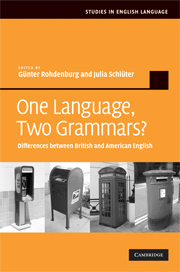Book contents
- Frontmatter
- Contents
- List of figures
- List of tables
- List of contributors
- Introduction
- 1 Colonial lag, colonial innovation or simply language change?
- 2 Compound verbs
- 3 The formation of the preterite and the past participle
- 4 Synthetic and analytic comparatives
- 5 Phonology and grammar
- 6 Prepositions and postpositions
- 7 Argument structure
- 8 Reflexive structures
- 9 Noun phrase modification
- 10 Nominal complements
- 11 Non-finite complements
- 12 The present perfect and the preterite
- 13 The revived subjunctive
- 14 The mandative subjunctive
- 15 The conditional subjunctive
- 16 Tag questions
- 17 The pragmatics of adverbs
- 18 How different are American and British English grammar? And how are they different?
- 19 New departures
- Bibliography
- Index
3 - The formation of the preterite and the past participle
Published online by Cambridge University Press: 03 July 2009
- Frontmatter
- Contents
- List of figures
- List of tables
- List of contributors
- Introduction
- 1 Colonial lag, colonial innovation or simply language change?
- 2 Compound verbs
- 3 The formation of the preterite and the past participle
- 4 Synthetic and analytic comparatives
- 5 Phonology and grammar
- 6 Prepositions and postpositions
- 7 Argument structure
- 8 Reflexive structures
- 9 Noun phrase modification
- 10 Nominal complements
- 11 Non-finite complements
- 12 The present perfect and the preterite
- 13 The revived subjunctive
- 14 The mandative subjunctive
- 15 The conditional subjunctive
- 16 Tag questions
- 17 The pragmatics of adverbs
- 18 How different are American and British English grammar? And how are they different?
- 19 New departures
- Bibliography
- Index
Summary
Introduction
The variation in preterite and past participle forms of verbs such as burn, dream, leap and spell is one of the most cited morphological differences between American English (AmE) and British English (BrE). It is mentioned as a regional feature in standard grammars such as Jespersen (1942: 32, 38), Quirk et al. (1985: 105–7) and Biber et al. (1999: 396–8), and handbooks such as Kövecses (2000: 190), Tottie (2002a: 150–1) and Trudgill and Hannah (2002: 56). Tottie (2002a: 150–1) summarizes the regional differences by stating that, although there is variation in both varieties, -ed is ‘[m]ore American’ and -t ‘[m]ore British’. Representative instances are seen in (1) to (4):
David Ginola once dreamed of displaying his skills in a major European city beginning with B. (The Independent 2000)
Whoever dreamt up the idea of five-day Test cricket clearly had too much time on their hands. (The Independent 2000)
AT&T's stock price leaped $6.125, or 11 percent, on Mr. Allen's news. (New York Times 1995)
And sugar leapt 41 percent. (New York Times 1995)
In the following the term regular will be used for verb forms ending in -ed and irregular for verbs ending in -t, in spite of the irregular verbs having several characteristics in common with regulars.
- Type
- Chapter
- Information
- One Language, Two Grammars?Differences between British and American English, pp. 60 - 85Publisher: Cambridge University PressPrint publication year: 2009
- 9
- Cited by



